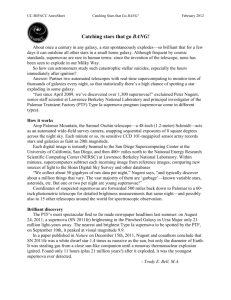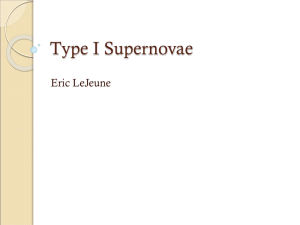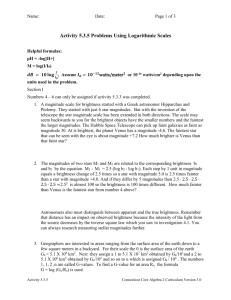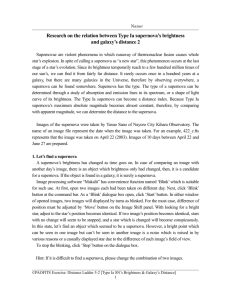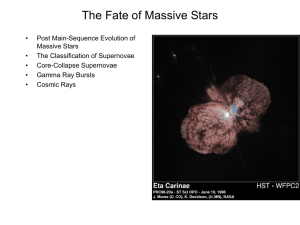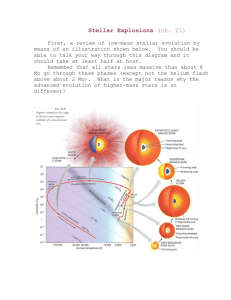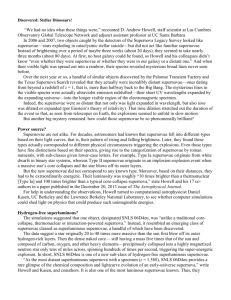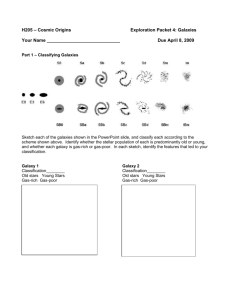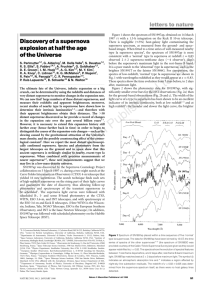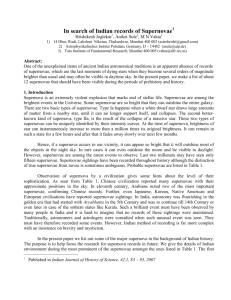Absolute Magnitudes of Supernovae
advertisement
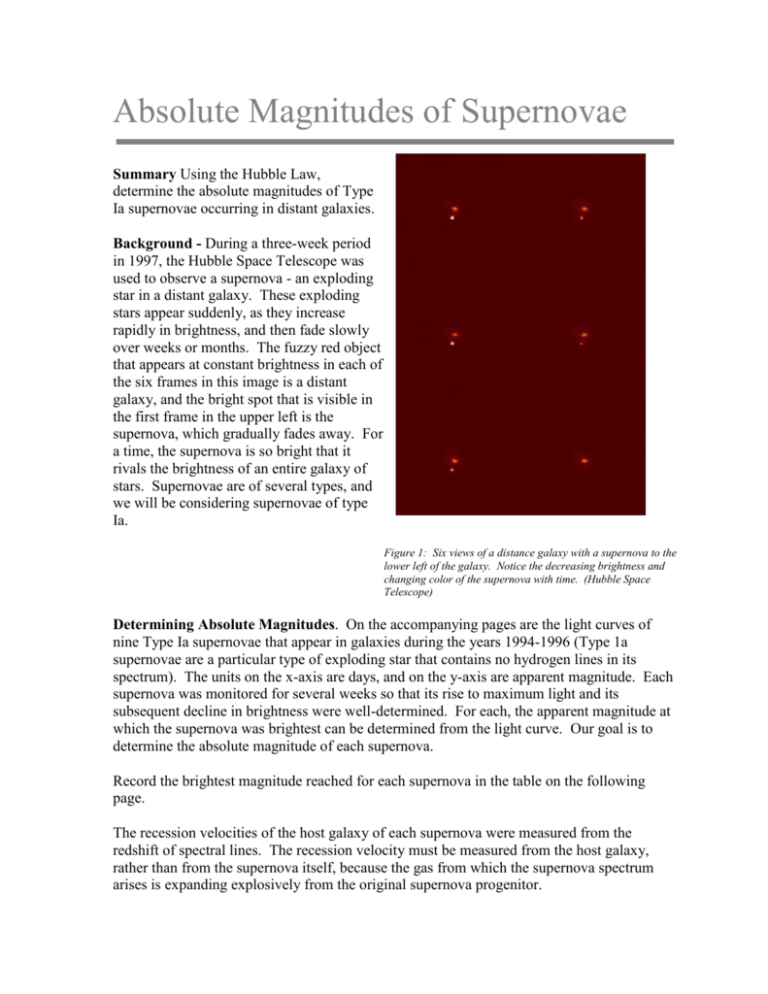
Absolute Magnitudes of Supernovae Summary Using the Hubble Law, determine the absolute magnitudes of Type Ia supernovae occurring in distant galaxies. Background - During a three-week period in 1997, the Hubble Space Telescope was used to observe a supernova - an exploding star in a distant galaxy. These exploding stars appear suddenly, as they increase rapidly in brightness, and then fade slowly over weeks or months. The fuzzy red object that appears at constant brightness in each of the six frames in this image is a distant galaxy, and the bright spot that is visible in the first frame in the upper left is the supernova, which gradually fades away. For a time, the supernova is so bright that it rivals the brightness of an entire galaxy of stars. Supernovae are of several types, and we will be considering supernovae of type Ia. Figure 1: Six views of a distance galaxy with a supernova to the lower left of the galaxy. Notice the decreasing brightness and changing color of the supernova with time. (Hubble Space Telescope) Determining Absolute Magnitudes. On the accompanying pages are the light curves of nine Type Ia supernovae that appear in galaxies during the years 1994-1996 (Type 1a supernovae are a particular type of exploding star that contains no hydrogen lines in its spectrum). The units on the x-axis are days, and on the y-axis are apparent magnitude. Each supernova was monitored for several weeks so that its rise to maximum light and its subsequent decline in brightness were well-determined. For each, the apparent magnitude at which the supernova was brightest can be determined from the light curve. Our goal is to determine the absolute magnitude of each supernova. Record the brightest magnitude reached for each supernova in the table on the following page. The recession velocities of the host galaxy of each supernova were measured from the redshift of spectral lines. The recession velocity must be measured from the host galaxy, rather than from the supernova itself, because the gas from which the supernova spectrum arises is expanding explosively from the original supernova progenitor. Use the value of the Hubble Law to compute the distance of the host galaxy (and the supernova) from the recession velocity. Remember that the distance = velocity / Ho. Now you can calculate the absolute magnitude from the distance and the apparent magnitude using the inverse square law. Recall that the distance in parsecs is related to the difference between the absolute and apparent magnitude as follows: Distance in parsecs = 10(m-M+5)/5 In this case, we know the distance and apparent magnitude and want to determine the absolute magnitude. The expression can be rewritten as M = m – 5 log(distance in parsecs) + 5 Use your calculator to obtain the logarithm of the distance in parsecs (the distance in parsecs is 106 times larger than the distance in megaparsecs. The absolute magnitudes of the supernovae should be negative, since the supernovae are very bright compared to ordinary stars. Remember that astronomical magnitudes become smaller, and then negative, as objects become brighter. Each 5 magnitudes is a factor of 100 in brightness. Supernova 1994S 1995D 1994ae 1995al 1995ac 1995bd 1996X Host Galaxy NGC 4495 NGC 2962 NGC 3370 NGC 3021 Anon UGC 3151 NGC 5061 z Recession velocity (km s-1) 0.01610 4,463 0.00655 1,998 0.06700 1,279 0.00514 1,536 0.04900 14,615 0.01520 4,758 0.00681 2,034 1996bl Anon 0.3480 10,598 1996bo NGC 673 0.01650 5,063 Mean Absolute Magnitude Median Absolute Magnitude Distance in Mpc for Ho=72 km s-1 Mpc-1 App Mag (mmax) 14.8 Absolute Magnitude (M) How does the brightness of a Type Ia supernova compare to the brightness of the Sun? The Sun's absolute magnitude is approximately 5. (The Sun's apparent magnitude is -26.) What can you conclude about the absolute magnitudes of Type Ia supernovae? What is peculiar about the supernova 1995bd? What explanation might account for its difference from other Type Ia supernovae? How might your conclusions about Type Ia supernovae be useful for determining the distances to other galaxies? This exercise is based on one developed by Lindsay Clark (see http://www.astro.princeton.edu/~clark/SNLab.html), and has been revised for use in the "Exploring the Dark Universe" workshop for teachers at Indiana University. The original data used in the exercise were obtained from Riess et al. 1999, AJ, 117, 707.
